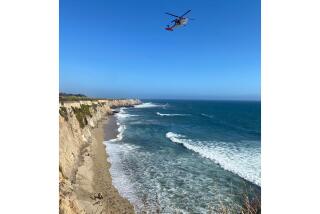Rescuer-in-Training Gets Some Real-Life Experience
SAN DIEGO — Navy Petty Officer 3rd Class Richard Pentony was back at work Monday, training to rescue downed pilots at sea by jumping out of a hovering helicopter.
But the 19-year-old from Vernon, N.J., now knows that he has what it takes to get the job done.
Pentony was aboard a SH-60F Seahawk helicopter on a training mission Thursday morning about 10 miles off the Baja California coast when a pilot of an F/A-18D Hornet from Miramar Marine Corps Air Station was forced to eject a few miles away.
Within minutes, the big helicopter, part of the Warhawks squadron at North Island Naval Air Station, was over the crash site.
Waves were littered with debris, and the sea was covered with a thin film of jet fuel.
Air Force Capt. Michael Suermann, groggy but conscious, was in a small raft, bobbing in the water. He had set off a rescue flare and was waving to draw attention.
Donning his wetsuit, Pentony jumped into the choppy seas, a drop of about 10 feet, and swam the 30 yards to Suermann.
“The training just kind of kicked in,” Pentony said, “and I went to work.”
Suermann, part of an Air Force-Marine pilot exchange program, expressed surprise at how quickly the rescue helicopter arrived. The helicopter, which had backed off to reduce the turbulence caused by its rotors, returned and dropped a rescue hook.
“I hooked myself to him and signaled for the hoist,” Pentony said.
“He was alert but a little shaken. It was all very fast, maybe 10 minutes.”
Suermann was covered with warm blankets, and within minutes the helicopter had landed at the Balboa Naval Hospital in San Diego. He was released within hours, shaken but not injured.
A military investigation into the crash will take months. During that time, Suermann is restricted from talking to the media.
Pentony, who gained his love of the water as a surfer on the New Jersey shore, is now in select company.
Helicopter Anti-Submarine Squadron 10 has trained more than 10,000 personnel in its 38-year history, but executed only about 100 rescues off Southern California.
“I had an adrenaline rush for about a day,” he said.
More to Read
Sign up for Essential California
The most important California stories and recommendations in your inbox every morning.
You may occasionally receive promotional content from the Los Angeles Times.










